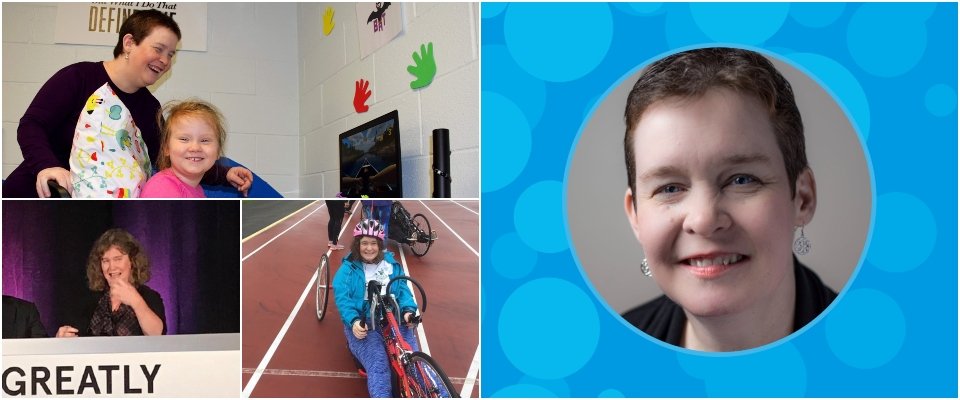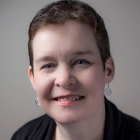You are here

Let’s Change the Future of Cerebral Palsy!
March is Cerebral Palsy Awareness Month
This March, the Burke Neurological Institute is joining the Cerebral Palsy Foundation and Reaching for the Stars in the celebration of Cerebral Palsy Awareness Month and a day of #GoGreen4CP on Thursday the 25th. We aim to push forward positive change in promoting inclusion in all areas of community life. Our goal is to create an environment where everyone—no matter their background—can succeed, feel a sense of belonging, and learn from one another. Building a culture of inclusion is an ongoing journey, we are committed to honoring diverse minds and beliefs held by all. With great honor, Dr. Kathleen M. Friel, a brilliant scientist and a key influencer in changing the future of cerebral palsy, shares with us her insightful perspective on cerebral palsy awareness.
Greater Awareness is Sorely Needed
My multi-faceted relationship with cerebral palsy (CP) gives me a rather unique perspective on CP awareness. The mission of my lab at BNI is to develop novel therapies for people with CP that are rooted in a deep understanding of the neurobiology of CP. Through our research, I’ve gotten to know hundreds of children and their families as they navigate life with CP. Most of you also know that I myself have CP—for those who have only ever met me over Zoom, now you know, it’s not my audio connection that garbles my speech! These perspectives all converge to one theme: greater awareness is sorely needed.
CP is not one set of impairments, rather it is an umbrella diagnosis of a variety of impairments, caused by brain injury or malformation before birth or during the first two years of life. While nearly all people with CP have movement impairments, some people also have impairments in sensation, vision, hearing, speech, and cognition. Approximately 3 in 1,000 people have CP, which translates to approximately 800,000 people in the United States, and over 18 million people worldwide—approximately 50-50% split between children and adults. To put these numbers in perspective, 800,000 people is equivalent to the population of Seattle, and 18 million individuals is equivalent to the population of the state of New York.
The Demand for Cerebral Palsy Research
Recently, research has demonstrated molecular and cellular consequences of CP. People with CP typically expend 3-5x the energy of their nondisabled peers to perform activities of daily living. Muscles and bones in people with CP have less of an organized structure than in nondisabled peers—interestingly, some of these structural differences occur before a baby shows motor symptoms of CP. This raises the possibility that muscle and bone cellular disorganization contributes to the development of motor symptoms, rather than emerge as a consequence of aberrant movement.
Much research is necessary. The work in my lab is focused on improving movement in school-aged children, to help kids gain more skillful movement ability, which then poises them to improve their confidence, quality of life, and independence. More work is needed to define early biomarkers of CP: despite most brain injuries occurring before or near the time of birth, kids are often not diagnosed until or after their first birthday. If we can diagnose early, we may find ways to intervene and prevent emergent impairments.
We also need therapies to help adults with CP age well—many adults with CP develop age-related conditions like osteoporosis decades before nondisabled peers. Adults with CP are more vulnerable to cancers, as I’ve learned in 2018 and was interviewed by Authority Magazine, “Unstoppable: How Dr. Kathleen Friel has made incredible accomplishments despite cerebral palsy and metastatic breast cancer”! Although CP is not a progressive neurological disorder, adults with CP experience greater pain, fatigue, and loss of mobility earlier in life than adults without CP.
Going Beyond the Science
Greater awareness about CP must go beyond the science. What’s it like to live with CP? I’m only one person, and my experiences do not generalize to all people with CP. Here’s a bit of my perspective. People often assume I have a cognitive impairment because of how I speak. It’s exhausting to deal with misperceptions. 2020 was a great year for avoiding unsuspecting strangers! By far, the most difficult aspect of my CP is my speech. Zoom chat is amazing, and trying to be understood while I’m wearing a mask is frustrating. Most importantly, people with CP—and other disabilities—want to be known as people. We have rich social lives, hobbies, favorite sports teams, and so much to offer. We’re more than the way we move or talk.
Did you know…? People with CP and other disabilities spearheaded landmark legislation that protects the rights of people with disabilities, including the Rehabilitation Act and the Americans with Disabilities Act. The movie Crip Camp shares their story (available on Netflix!). In one part of the movie, people with disabilities held a sit-in in Sacramento to fight for accessibility in the 1970s. At one point, the disgruntled police shut off the phone system, so people could not call their supporters outside. Shortly after, some deaf participants went to the windows of the building and used sign language to communicate with the people outside. The police couldn’t stop them, and eventually conceded!
What You Can Do
Take the time to listen. Think about accessibility when you plan social outings and events. People with physical limitations have so much to offer! Don’t dismiss us or view us as burdens or liabilities. Listen to us, engage with us as equals. We will do the same for you.
What do I envision for the CP community in 2021? I look forward to escaping my apartment, that’s for sure! There are some exciting projects in the works around the nation, including searching for genetic contributors to CP, expanding the workforce to include more people with CP, and finding better early detection tools for CP diagnoses. For the first time ever, the Paralympics will be broadcast on network television – from Tokyo this summer! With hard work and openness, we can make the world an even better, more welcoming place for people with CP.


